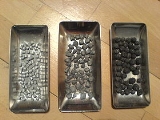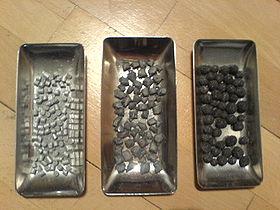
Pyrotechnic star
Encyclopedia
Pyrotechnic stars are pellets
or simply pieces of pyrotechnic composition which may contain metal powders, salts or other compounds that, when ignited, burn a certain colour or exude a spark effect. They are a part of all projectile
-type fireworks
. The most common is the aerial shell. When watching this firework, it will launch into the sky, burning a lifting charge. Once the shell has attained proper altitude, due to other mechanisms within the firework, it will ignite the stars.

The stars are allowed to dry for some days before being put into the fireworks piece.
Priming the stars is often necessary because they may be hard to ignite. Priming consists of coating the surface of the star with a more easily ignited substance, such as black powder.
s. When used in aerial shells, the stars may sometimes be required to be "primed" with an ignition coating, consisting of a pyrotechnic mixture with an ignition temperature lower than that of the star. This is usually done if the star composition does not ignite easily.
Pelletizing
Pelletizing is the process of compressing or molding a material into the shape of a pellet. A wide range of different materials are pelletized including chemicals, iron ore, animal compound feed, and more.- Pelletizing of iron ore :...
or simply pieces of pyrotechnic composition which may contain metal powders, salts or other compounds that, when ignited, burn a certain colour or exude a spark effect. They are a part of all projectile
Projectile
A projectile is any object projected into space by the exertion of a force. Although a thrown baseball is technically a projectile too, the term more commonly refers to a weapon....
-type fireworks
Fireworks
Fireworks are a class of explosive pyrotechnic devices used for aesthetic and entertainment purposes. The most common use of a firework is as part of a fireworks display. A fireworks event is a display of the effects produced by firework devices...
. The most common is the aerial shell. When watching this firework, it will launch into the sky, burning a lifting charge. Once the shell has attained proper altitude, due to other mechanisms within the firework, it will ignite the stars.

Procedure
Stars are either rolled, pumped or cut.- Rolled stars are small cores of a hard material (often lead shot or an organic material such as mustard seeds or even cut stars) which are coated in a rotating mixer similar to a concrete mixerConcrete mixerA concrete mixer is a device that homogeneously combines cement, aggregate such as sand or gravel, and water to form concrete. A typical concrete mixer uses a revolving drum to mix the components...
. First some water is sprayed on cores. Then an amount of a pyrotechnic compositionPyrotechnic compositionA pyrotechnic composition is a substance or mixture of substances designed to produce an effect by heat, light, sound, gas or smoke or a combination of these, as a result of non-detonative self-sustaining exothermic chemical reactions...
is dropped into the mixer. These two steps are repeated, and the stars will grow bigger and bigger into a spherical shape. - Pumped stars are stars that have been pumped using a star pump. A dampened composition is put in the star pump and is pressed against a flat surface and ejected again, creating cylinder shaped stars.
- Cut stars is a dampened composition spread out to an even layer on a flat surface. The stars are then cut into cubes.
The stars are allowed to dry for some days before being put into the fireworks piece.
Priming the stars is often necessary because they may be hard to ignite. Priming consists of coating the surface of the star with a more easily ignited substance, such as black powder.
Putting Into Use
Stars can be used in aerial shells, roman candles, star mines, and certain bottle rocketBottle rocket
A bottle rocket is a very small skyrocket. A typical bottle rocket consists of a rocket engine attached to a stabilizing stick. The user can place the stick in an empty bottle , and ignite the rocket engine; the mouth of the bottle guides the stick, stabilizing the rocket in its first moments of...
s. When used in aerial shells, the stars may sometimes be required to be "primed" with an ignition coating, consisting of a pyrotechnic mixture with an ignition temperature lower than that of the star. This is usually done if the star composition does not ignite easily.

